Study of the Role of Lipoprotein Maturation Enzymes in the Pathogenesis of the Infection Caused by the Streptococcus suis Serotype 2 Sequence Type 25 North American Prototype Strain
Abstract
:1. Introduction
2. Materials and Methods
2.1. Bacterial Strains and Growth Conditions
2.2. DNA Manipulations
2.3. Construction of the Lipoprotein Maturation Isogenic Mutants
2.4. Complementation of the Mutants
2.5. Growth Analysis
2.6. Bacterial Surface Hydrophobicity Assay
2.7. Bacterial Adhesion and Invasion Assays Using Porcine Brain Microvascular Endothelial and Tracheal Epithelial Cells
2.8. Biofilm Assay
2.9. Generation of Bone-Marrow-Derived Dendritic Cells (bmDCs)
2.10. Preparation of Heat-Killed S. suis
2.11. Preparation of Bacterial Supernatant
2.12. S. suis Activation of bmDCs
2.13. S. suis Virulence Mouse Model of Systemic Infection
2.14. Measurement of Plasma (Systemic) Pro-Inflammatory Mediators
2.15. Statistical Analyses
3. Results
3.1. Characteristics of the Δlgt and Δlsp Mutants Derived from the ST25 89-1591 Strain
3.2. Lack of Lipoprotein Maturation Enzymes Does Not Impair Adhesion to and Invasion of Respiratory Epithelial and Brain Microvascular Endothelial Swine Cells Regardless of the Sequence Type of the Strain
3.3. Lgt and Lsp Enzymes Are Important for S. suis Biofilm Formation Regardless of the Sequence Type of the Strain
3.4. The Diacyl Motif and the Peptide Signal Cleavage Are Important for the Recognition by Innate Immune Cells of Periplasmic and/or Secreted Lipoproteins of S. suis Serotype 2 ST25 Strain
3.5. The Absence of Lgt Enzyme, but Not Lsp, Significantly Affects the Virulence of S. suis Serotype 2 ST25
3.6. Absence of the Lgt or Lsp Enzymes Significantly Reduces the In Vivo Inflammatory Response of Mice Infected with Either the Wild Type S. suis Serotype 2 Strain ST25 or Its Respective Δlgt or Δlsp Mutant
4. Discussion
5. Conclusions
Author Contributions
Funding
Institutional Review Board Statement
Informed Consent Statement
Data Availability Statement
Acknowledgments
Conflicts of Interest
References
- Gottschalk, M.; Xu, J.; Calzas, C.; Segura, M. Streptococcus suis: A new emerging or an old neglected zoonotic pathogen? Future Microbiol. 2010, 5, 371–391. [Google Scholar] [CrossRef] [PubMed]
- Goyette-Desjardins, G.; Auger, J.P.; Xu, J.; Segura, M.; Gottschalk, M. Streptococcus suis, an important pig pathogen and emerging zoonotic agent-an update on the worldwide distribution based on serotyping and sequence typing. Emerg. Microbes Infect. 2014, 3, e45. [Google Scholar] [CrossRef] [PubMed]
- Tan, C.; Zhang, A.; Chen, H.; Zhou, R. Recent Proceedings on Prevalence and Pathogenesis of Streptococcus suis. Curr. Issues Mol. Biol. 2019, 32, 473–520. [Google Scholar] [CrossRef] [PubMed]
- Yu, H.; Jing, H.; Chen, Z.; Zheng, H.; Zhu, X.; Wang, H.; Wang, S.; Liu, L.; Zu, R.; Luo, L.; et al. Human Streptococcus suis outbreak, Sichuan, China. Emerg. Infect. Dis. 2006, 12, 914–920. [Google Scholar] [CrossRef]
- Berthelot-Herault, F.; Gottschalk, M.; Morvan, H.; Kobisch, M. Dilemma of virulence of Streptococcus suis: Canadian isolate 89-1591 characterized as a virulent strain using a standardized experimental model in pigs. Can. J. Vet. Res. 2005, 69, 236–240. [Google Scholar]
- Lacouture, S.; Olivera, Y.R.; Mariela, S.; Gottschalk, M. Distribution and characterization of Streptococcus suis serotypes isolated from January 2015 to June 2020 from diseased pigs in Quebec, Canada. Can. J. Vet. Res. 2022, 86, 78–82. [Google Scholar]
- Fittipaldi, N.; Segura, M.; Grenier, D.; Gottschalk, M. Virulence factors involved in the pathogenesis of the infection caused by the swine pathogen and zoonotic agent Streptococcus suis. Future Microbiol. 2012, 7, 259–279. [Google Scholar] [CrossRef]
- Payen, S.; Roy, D.; Boa, A.; Okura, M.; Auger, J.P.; Segura, M.; Gottschalk, M. Role of Maturation of Lipoproteins in the Pathogenesis of the Infection Caused by Streptococcus suis Serotype 2. Microorganisms 2021, 9, 2386. [Google Scholar] [CrossRef]
- Kovacs-Simon, A.; Titball, R.W.; Michell, S.L. Lipoproteins of bacterial pathogens. Infect. Immun. 2011, 79, 548–561. [Google Scholar] [CrossRef]
- Kohler, S.; Voss, F.; Mejia, A.G.; Brown, J.S.; Hammerschmidt, S. Pneumococcal lipoproteins involved in bacterial fitness, virulence, and immune evasion. FEBS Lett. 2016, 590, 3820–3839. [Google Scholar] [CrossRef]
- Sander, P.; Rezwan, M.; Walker, B.; Rampini, S.K.; Kroppenstedt, R.M.; Ehlers, S.; Keller, C.; Keeble, J.R.; Hagemeier, M.; Colston, M.J.; et al. Lipoprotein processing is required for virulence of Mycobacterium tuberculosis. Mol. Microbiol. 2004, 52, 1543–1552. [Google Scholar] [CrossRef] [PubMed]
- Henneke, P.; Dramsi, S.; Mancuso, G.; Chraibi, K.; Pellegrini, E.; Theilacker, C.; Hubner, J.; Santos-Sierra, S.; Teti, G.; Golenbock, D.T.; et al. Lipoproteins are critical TLR2 activating toxins in group B streptococcal sepsis. J. Immunol. 2008, 180, 6149–6158. [Google Scholar] [CrossRef] [PubMed]
- Hashimoto, M.; Tawaratsumida, K.; Kariya, H.; Kiyohara, A.; Suda, Y.; Krikae, F.; Kirikae, T.; Gotz, F. Not lipoteichoic acid but lipoproteins appear to be the dominant immunobiologically active compounds in Staphylococcus aureus. J. Immunol. 2006, 177, 3162–3169. [Google Scholar] [CrossRef]
- Hutchings, M.I.; Palmer, T.; Harrington, D.J.; Sutcliffe, I.C. Lipoprotein biogenesis in Gram-positive bacteria: Knowing when to hold ‘em, knowing when to fold ‘em. Trends Microbiol. 2009, 17, 13–21. [Google Scholar] [CrossRef]
- Smithers, L.; Olatunji, S.; Caffrey, M. Bacterial Lipoprotein Posttranslational Modifications. New Insights and Opportunities for Antibiotic and Vaccine Development. Front. Microbiol. 2021, 12, 788445. [Google Scholar] [CrossRef]
- Auger, J.P.; Dolbec, D.; Roy, D.; Segura, M.; Gottschalk, M. Role of the Streptococcus suis serotype 2 capsular polysaccharide in the interactions with dendritic cells is strain-dependent but remains critical for virulence. PLoS ONE 2018, 13, e0200453. [Google Scholar] [CrossRef]
- Lavagna, A.; Auger, J.P.; Girardin, S.E.; Gisch, N.; Segura, M.; Gottschalk, M. Recognition of Lipoproteins by Toll-like Receptor 2 and DNA by the AIM2 Inflammasome Is Responsible for Production of Interleukin-1beta by Virulent Suilysin-negative Streptococcus suis Serotype 2. Pathogens 2020, 9, 147. [Google Scholar] [CrossRef]
- Dolbec, D.; Lehoux, M.; Okura, M.; Takamatsu, D.; Gottschalk, M.; Segura, M. Streptococcus suis surface-antigen recognition by antibodies and bacterial elimination is influenced by capsular polysaccharide structure. Front. Cell Infect. Microbiol. 2023, 13, 1228496. [Google Scholar] [CrossRef]
- Lecours, M.P.; Segura, M.; Fittipaldi, N.; Rivest, S.; Gottschalk, M. Immune receptors involved in Streptococcus suis recognition by dendritic cells. PLoS ONE 2012, 7, e44746. [Google Scholar] [CrossRef]
- Gottschalk, M.; Higgins, R.; Boudreau, M. Use of polyvalent coagglutination reagents for serotyping of Streptococcus suis. J. Clin. Microbiol. 1993, 31, 2192–2194. [Google Scholar] [CrossRef]
- Slater, J.D.; Allen, A.G.; May, J.P.; Bolitho, S.; Lindsay, H.; Maskell, D.J. Mutagenesis of Streptococcus equi and Streptococcus suis by transposon Tn917. Vet. Microbiol. 2003, 93, 197–206. [Google Scholar] [CrossRef] [PubMed]
- Lecours, M.P.; Gottschalk, M.; Houde, M.; Lemire, P.; Fittipaldi, N.; Segura, M. Critical role for Streptococcus suis cell wall modifications and suilysin in resistance to complement-dependent killing by dendritic cells. J. Infect. Dis. 2011, 204, 919–929. [Google Scholar] [CrossRef] [PubMed]
- Gottschalk, M.; Higgins, R.; Jacques, M.; Dubreuil, D. Production and characterization of two Streptococcus suis capsular type 2 mutants. Vet. Microbiol. 1992, 30, 59–71. [Google Scholar] [CrossRef] [PubMed]
- Casadaban, M.J.; Cohen, S.N. Analysis of gene control signals by DNA fusion and cloning in Escherichia coli. J. Mol. Biol. 1980, 138, 179–207. [Google Scholar] [CrossRef]
- Takamatsu, D.; Osaki, M.; Sekizaki, T. Thermosensitive suicide vectors for gene replacement in Streptococcus suis. Plasmid 2001, 46, 140–148. [Google Scholar] [CrossRef]
- Okura, M.; Osaki, M.; Fittipaldi, N.; Gottschalk, M.; Sekizaki, T.; Takamatsu, D. The minor pilin subunit Sgp2 is necessary for assembly of the pilus encoded by the srtG cluster of Streptococcus suis. J. Bacteriol. 2011, 193, 822–831. [Google Scholar] [CrossRef]
- Warrens, A.N.; Jones, M.D.; Lechler, R.I. Splicing by overlap extension by PCR using asymmetric amplification: An improved technique for the generation of hybrid proteins of immunological interest. Gene 1997, 186, 29–35. [Google Scholar] [CrossRef]
- Takamatsu, D.; Osaki, M.; Sekizaki, T. Construction and characterization of Streptococcus suis-Escherichia coli shuttle cloning vectors. Plasmid 2001, 45, 101–113. [Google Scholar] [CrossRef]
- Teifel, M.; Friedl, P. Establishment of the permanent microvascular endothelial cell line PBMEC/C1-2 from porcine brains. Exp. Cell Res. 1996, 228, 50–57. [Google Scholar] [CrossRef]
- Ferrari, M.; Scalvini, A.; Losio, M.N.; Corradi, A.; Soncini, M.; Bignotti, E.; Milanesi, E.; Ajmone-Marsan, P.; Barlati, S.; Bellotti, D.; et al. Establishment and characterization of two new pig cell lines for use in virological diagnostic laboratories. J. Virol. Methods 2003, 107, 205–212. [Google Scholar] [CrossRef]
- Auger, E.; Deslandes, V.; Ramjeet, M.; Contreras, I.; Nash, J.H.; Harel, J.; Gottschalk, M.; Olivier, M.; Jacques, M. Host-pathogen interactions of Actinobacillus pleuropneumoniae with porcine lung and tracheal epithelial cells. Infect. Immun. 2009, 77, 1426–1441. [Google Scholar] [CrossRef] [PubMed]
- Wang, Y.; Gagnon, C.A.; Savard, C.; Music, N.; Srednik, M.; Segura, M.; Lachance, C.; Bellehumeur, C.; Gottschalk, M. Capsular sialic acid of Streptococcus suis serotype 2 binds to swine influenza virus and enhances bacterial interactions with virus-infected tracheal epithelial cells. Infect. Immun. 2013, 81, 4498–4508. [Google Scholar] [CrossRef] [PubMed]
- Vanier, G.; Segura, M.; Friedl, P.; Lacouture, S.; Gottschalk, M. Invasion of porcine brain microvascular endothelial cells by Streptococcus suis serotype 2. Infect. Immun. 2004, 72, 1441–1449. [Google Scholar] [CrossRef] [PubMed]
- Payen, S.; Rrodriguez, J.A.; Segura, M.; Gottschalk, M. Laminin-binding protein of Streptococcus suis serotype 2 influences zinc acquisition and cytokine responses. Vet. Res. 2023, 54, 1. [Google Scholar] [CrossRef]
- Vanier, G.; Segura, M.; Lecours, M.P.; Grenier, D.; Gottschalk, M. Porcine brain microvascular endothelial cell-derived interleukin-8 is first induced and then degraded by Streptococcus suis. Microb. Pathog. 2009, 46, 135–143. [Google Scholar] [CrossRef]
- Bonifait, L.; Grignon, L.; Grenier, D. Fibrinogen induces biofilm formation by Streptococcus suis and enhances its antibiotic resistance. Appl. Environ. Microbiol. 2008, 74, 4969–4972. [Google Scholar] [CrossRef]
- Segura, M.; Su, Z.; Piccirillo, C.; Stevenson, M.M. Impairment of dendritic cell function by excretory-secretory products: A potential mechanism for nematode-induced immunosuppression. Eur. J. Immunol. 2007, 37, 1887–1904. [Google Scholar] [CrossRef]
- Segura, M.; Stankova, J.; Gottschalk, M. Heat-killed Streptococcus suis capsular type 2 strains stimulate tumor necrosis factor alpha and interleukin-6 production by murine macrophages. Infect. Immun. 1999, 67, 4646–4654. [Google Scholar] [CrossRef]
- Lachance, C.; Gottschalk, M.; Gerber, P.P.; Lemire, P.; Xu, J.; Segura, M. Exacerbated type II interferon response drives hypervirulence and toxic shock by an emergent epidemic strain of Streptococcus suis. Infect. Immun. 2013, 81, 1928–1939. [Google Scholar] [CrossRef]
- Auger, J.P.; Fittipaldi, N.; Benoit-Biancamano, M.O.; Segura, M.; Gottschalk, M. Virulence Studies of Different Sequence Types and Geographical Origins of Streptococcus suis Serotype 2 in a Mouse Model of Infection. Pathogens 2016, 5, 48. [Google Scholar] [CrossRef]
- Donlan, R.M.; Costerton, J.W. Biofilms: Survival mechanisms of clinically relevant microorganisms. Clin. Microbiol. Rev. 2002, 15, 167–193. [Google Scholar] [CrossRef]
- Peng, M.; Xu, Y.; Dou, B.; Yang, F.; He, Q.; Liu, Z.; Gao, T.; Liu, W.; Yang, K.; Guo, R.; et al. The adcA and lmb Genes Play an Important Role in Drug Resistance and Full Virulence of Streptococcus suis. Microbiol. Spectr. 2023, 11, e0433722. [Google Scholar] [CrossRef] [PubMed]
- Auger, J.P.; Chuzeville, S.; Roy, D.; Mathieu-Denoncourt, A.; Xu, J.; Grenier, D.; Gottschalk, M. The bias of experimental design, including strain background, in the determination of critical Streptococcus suis serotype 2 virulence factors. PLoS ONE 2017, 12, e0181920. [Google Scholar] [CrossRef] [PubMed]
- Tenenbaum, T.; Asmat, T.M.; Seitz, M.; Schroten, H.; Schwerk, C. Biological activities of suilysin: Role in Streptococcus suis pathogenesis. Future Microbiol. 2016, 11, 941–954. [Google Scholar] [CrossRef]
- Fittipaldi, N.; Fuller, T.E.; Teel, J.F.; Wilson, T.L.; Wolfram, T.J.; Lowery, D.E.; Gottschalk, M. Serotype distribution and production of muramidase-released protein, extracellular factor and suilysin by field strains of Streptococcus suis isolated in the United States. Vet. Microbiol. 2009, 139, 310–317. [Google Scholar] [CrossRef] [PubMed]
- Stoll, H.; Dengjel, J.; Nerz, C.; Gotz, F. Staphylococcus aureus deficient in lipidation of prelipoproteins is attenuated in growth and immune activation. Infect. Immun. 2005, 73, 2411–2423. [Google Scholar] [CrossRef]
- Chimalapati, S.; Cohen, J.M.; Camberlein, E.; MacDonald, N.; Durmort, C.; Vernet, T.; Hermans, P.W.; Mitchell, T.; Brown, J.S. Effects of deletion of the Streptococcus pneumoniae lipoprotein diacylglyceryl transferase gene lgt on ABC transporter function and on growth in vivo. PLoS ONE 2012, 7, e41393. [Google Scholar] [CrossRef]
- Pribyl, T.; Moche, M.; Dreisbach, A.; Bijlsma, J.J.; Saleh, M.; Abdullah, M.R.; Hecker, M.; van Dijl, J.M.; Becher, D.; Hammerschmidt, S. Influence of impaired lipoprotein biogenesis on surface and exoproteome of Streptococcus pneumoniae. J. Proteome Res. 2014, 13, 650–667. [Google Scholar] [CrossRef]
- Reglier-Poupet, H.; Frehel, C.; Dubail, I.; Beretti, J.L.; Berche, P.; Charbit, A.; Raynaud, C. Maturation of lipoproteins by type II signal peptidase is required for phagosomal escape of Listeria monocytogenes. J. Biol. Chem. 2003, 278, 49469–49477. [Google Scholar] [CrossRef]
- Hamilton, A.; Robinson, C.; Sutcliffe, I.C.; Slater, J.; Maskell, D.J.; Davis-Poynter, N.; Smith, K.; Waller, A.; Harrington, D.J. Mutation of the maturase lipoprotein attenuates the virulence of Streptococcus equi to a greater extent than does loss of general lipoprotein lipidation. Infect. Immun. 2006, 74, 6907–6919. [Google Scholar] [CrossRef]
- Chuzeville, S.; Auger, J.P.; Dumesnil, A.; Roy, D.; Lacouture, S.; Fittipaldi, N.; Grenier, D.; Gottschalk, M. Serotype-specific role of antigen I/II in the initial steps of the pathogenesis of the infection caused by Streptococcus suis. Vet. Res. 2017, 48, 39. [Google Scholar] [CrossRef] [PubMed]
- Segura, M.; Fittipaldi, N.; Calzas, C.; Gottschalk, M. Critical Streptococcus suis Virulence Factors: Are They All Really Critical? Trends Microbiol. 2017, 25, 585–599. [Google Scholar] [CrossRef] [PubMed]
- Segura, M.; Calzas, C.; Grenier, D.; Gottschalk, M. Initial steps of the pathogenesis of the infection caused by Streptococcus suis: Fighting against nonspecific defenses. FEBS Lett. 2016, 590, 3772–3799. [Google Scholar] [CrossRef] [PubMed]
- Zhao, L.; Gao, X.; Liu, C.; Lv, X.; Jiang, N.; Zheng, S. Deletion of the vacJ gene affects the biology and virulence in Haemophilus parasuis serovar 5. Gene 2017, 603, 42–53. [Google Scholar] [CrossRef]
- Xie, F.; Li, G.; Zhang, W.; Zhang, Y.; Zhou, L.; Liu, S.; Liu, S.; Wang, C. Outer membrane lipoprotein VacJ is required for the membrane integrity, serum resistance and biofilm formation of Actinobacillus pleuropneumoniae. Vet. Microbiol. 2016, 183, 1–8. [Google Scholar] [CrossRef]
- Mitrakul, K.; Loo, C.Y.; Gyurko, C.; Hughes, C.V.; Ganeshkumar, N. Mutational analysis of the adcCBA genes in Streptococcus gordonii biofilm formation. Oral Microbiol. Immunol. 2005, 20, 122–127. [Google Scholar] [CrossRef]
- Park, O.J.; Jung, S.; Park, T.; Kim, A.R.; Lee, D.; Ji, H.J.; Seo, H.S.; Yun, C.H.; Han, S.H. Enhanced biofilm formation of Streptococcus gordonii with lipoprotein deficiency. Mol. Oral. Microbiol. 2020, 35, 271–278. [Google Scholar] [CrossRef]
- Nepper, J.F.; Lin, Y.C.; Weibel, D.B. Rcs Phosphorelay Activation in Cardiolipin-Deficient Escherichia coli Reduces Biofilm Formation. J. Bacteriol. 2019, 201, e00804-18. [Google Scholar] [CrossRef]
- Schreur, P.J.W.; Rebel, J.M.; Smits, M.A.; van Putten, J.P.; Smith, H.E. Differential activation of the Toll-like receptor 2/6 complex by lipoproteins of Streptococcus suis serotypes 2 and 9. Vet. Microbiol. 2010, 143, 363–370. [Google Scholar] [CrossRef]
- Nguyen, M.T.; Gotz, F. Lipoproteins of Gram-Positive Bacteria: Key Players in the Immune Response and Virulence. Microbiol. Mol. Biol. Rev. 2016, 80, 891–903. [Google Scholar] [CrossRef]
- Petit, C.M.; Brown, J.R.; Ingraham, K.; Bryant, A.P.; Holmes, D.J. Lipid modification of prelipoproteins is dispensable for growth in vitro but essential for virulence in Streptococcus pneumoniae. FEMS Microbiol. Lett. 2001, 200, 229–233. [Google Scholar] [CrossRef]
- Fittipaldi, N.; Xu, J.; Lacouture, S.; Tharavichitkul, P.; Osaki, M.; Sekizaki, T.; Takamatsu, D.; Gottschalk, M. Lineage and virulence of Streptococcus suis serotype 2 isolates from North America. Emerg. Infect. Dis. 2011, 17, 2239–2244. [Google Scholar] [CrossRef] [PubMed]
- Baums, C.G.; Valentin-Weigand, P. Surface-associated and secreted factors of Streptococcus suis in epidemiology, pathogenesis and vaccine development. Anim. Health Res. Rev. 2009, 10, 65–83. [Google Scholar] [CrossRef] [PubMed]
- Lavagna, A.; Auger, J.P.; Dumesnil, A.; Roy, D.; Girardin, S.E.; Gisch, N.; Segura, M.; Gottschalk, M. Interleukin-1 signaling induced by Streptococcus suis serotype 2 is strain-dependent and contributes to bacterial clearance and inflammation during systemic disease in a mouse model of infection. Vet. Res. 2019, 50, 52. [Google Scholar] [CrossRef] [PubMed]
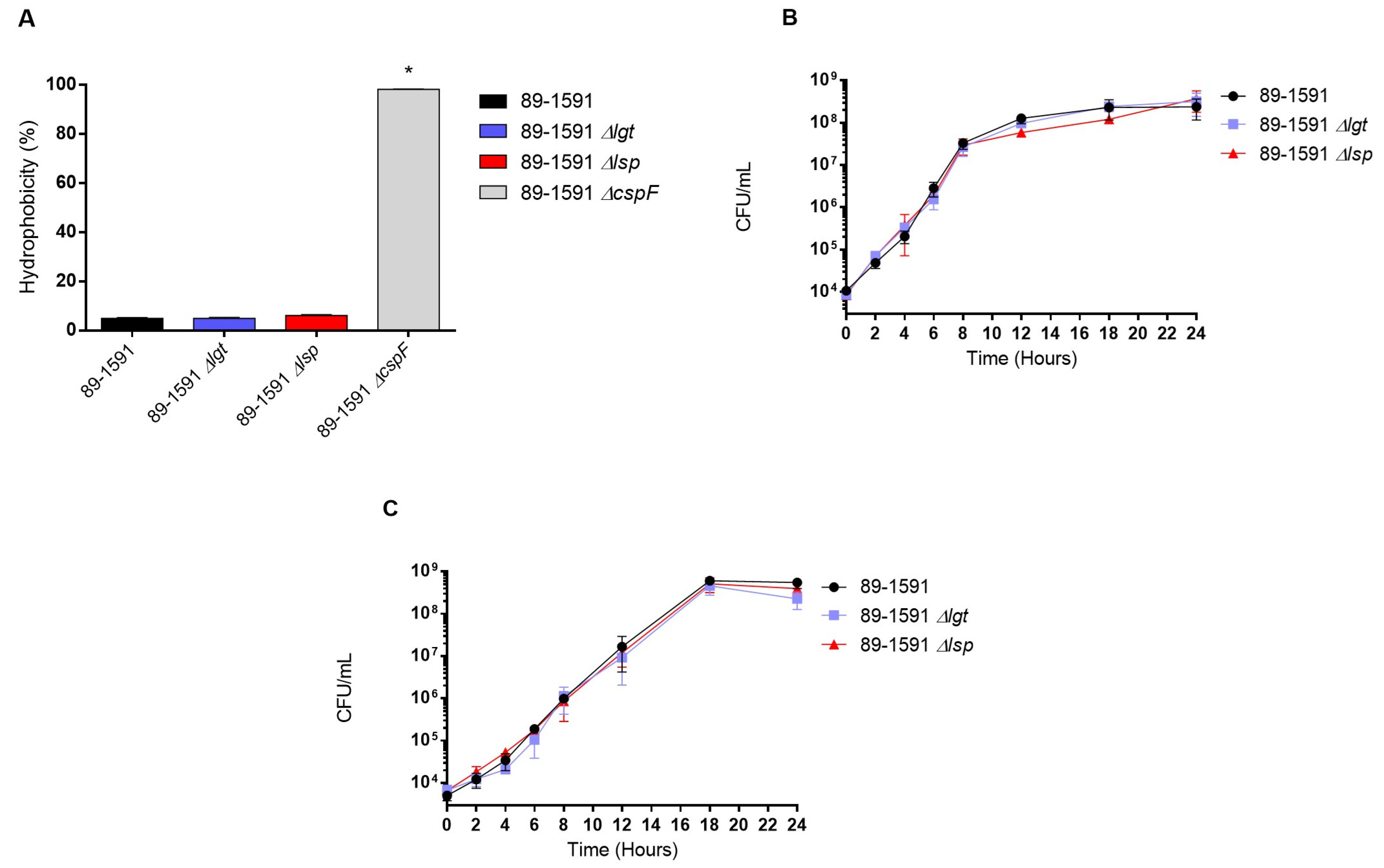
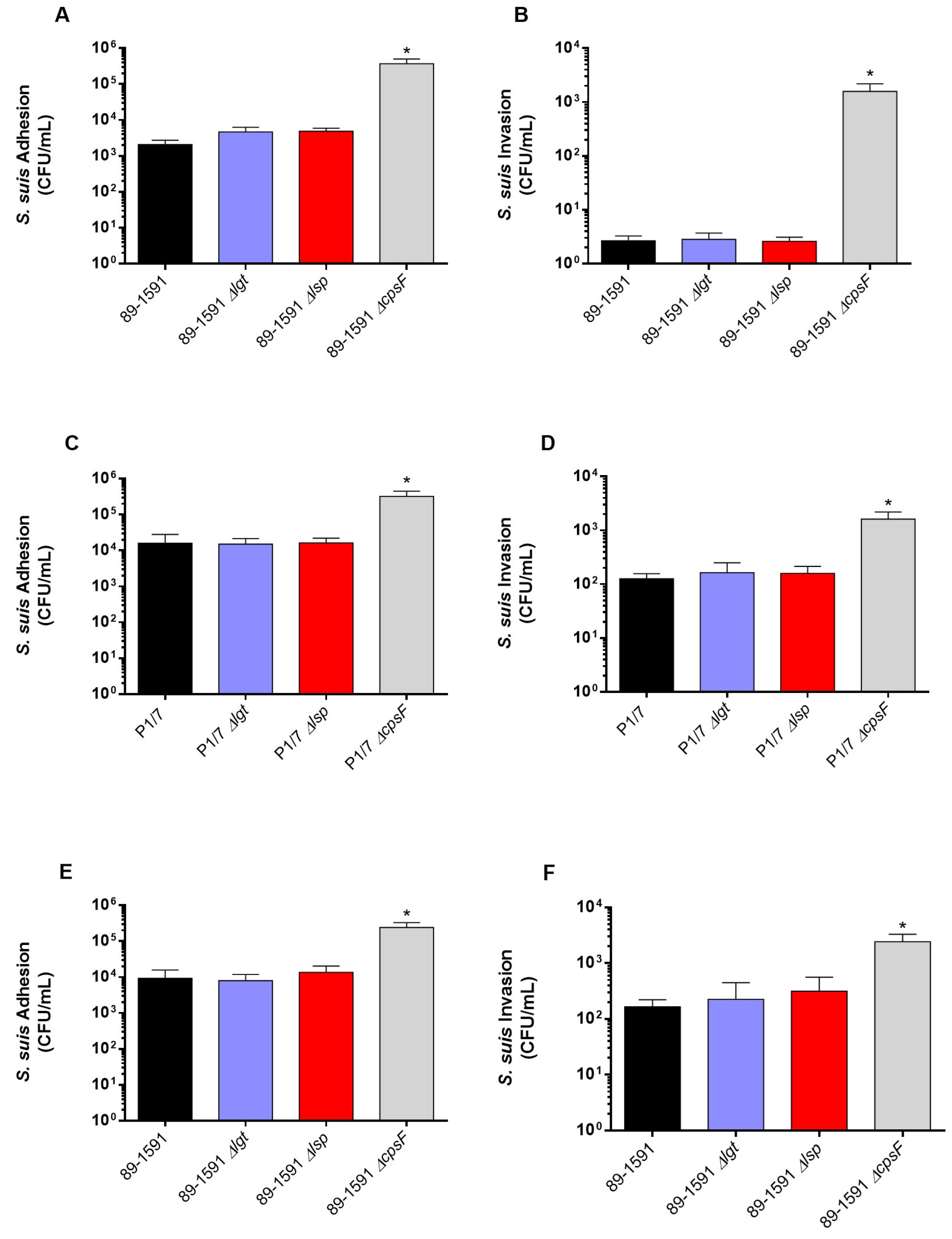
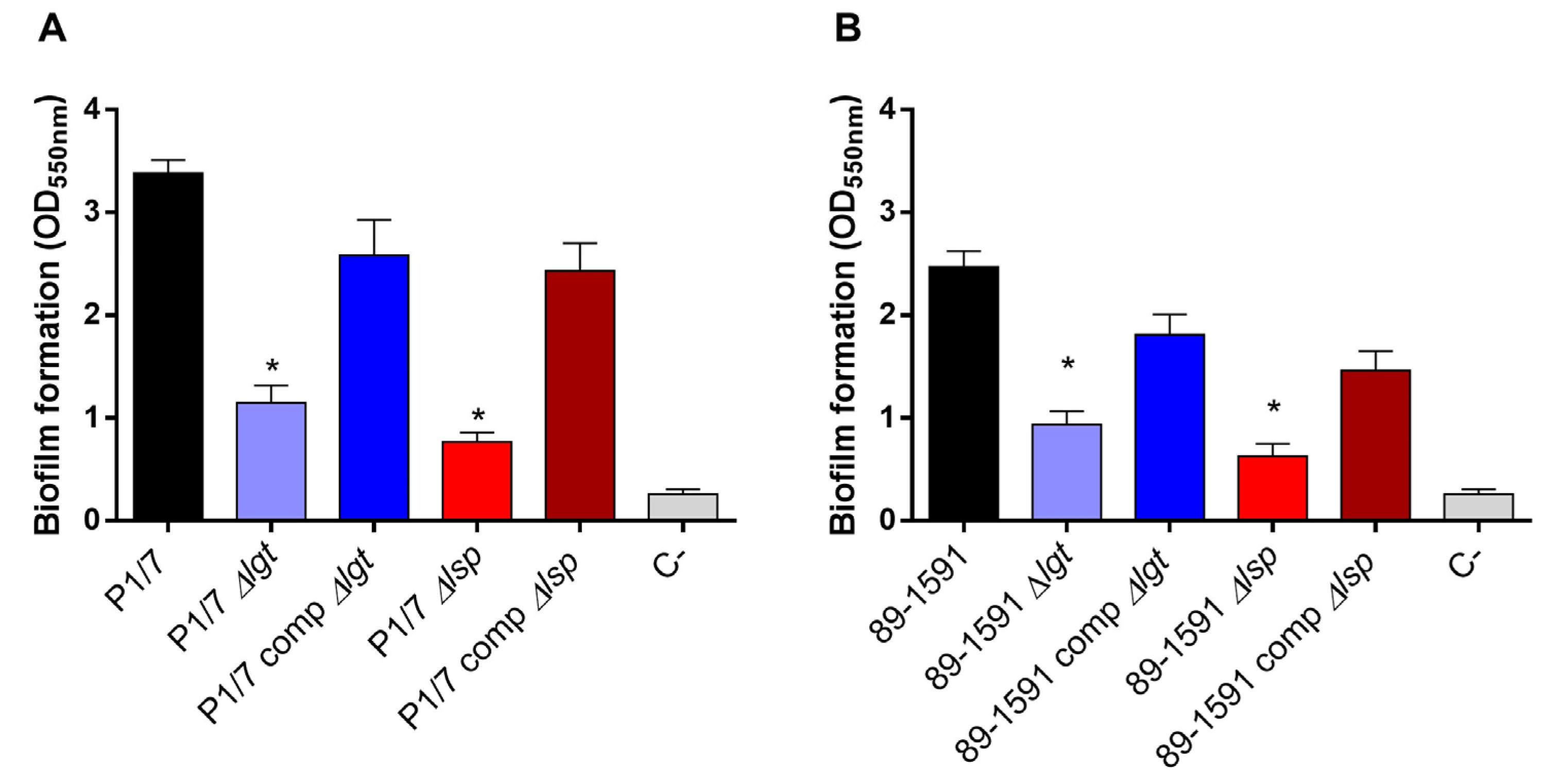

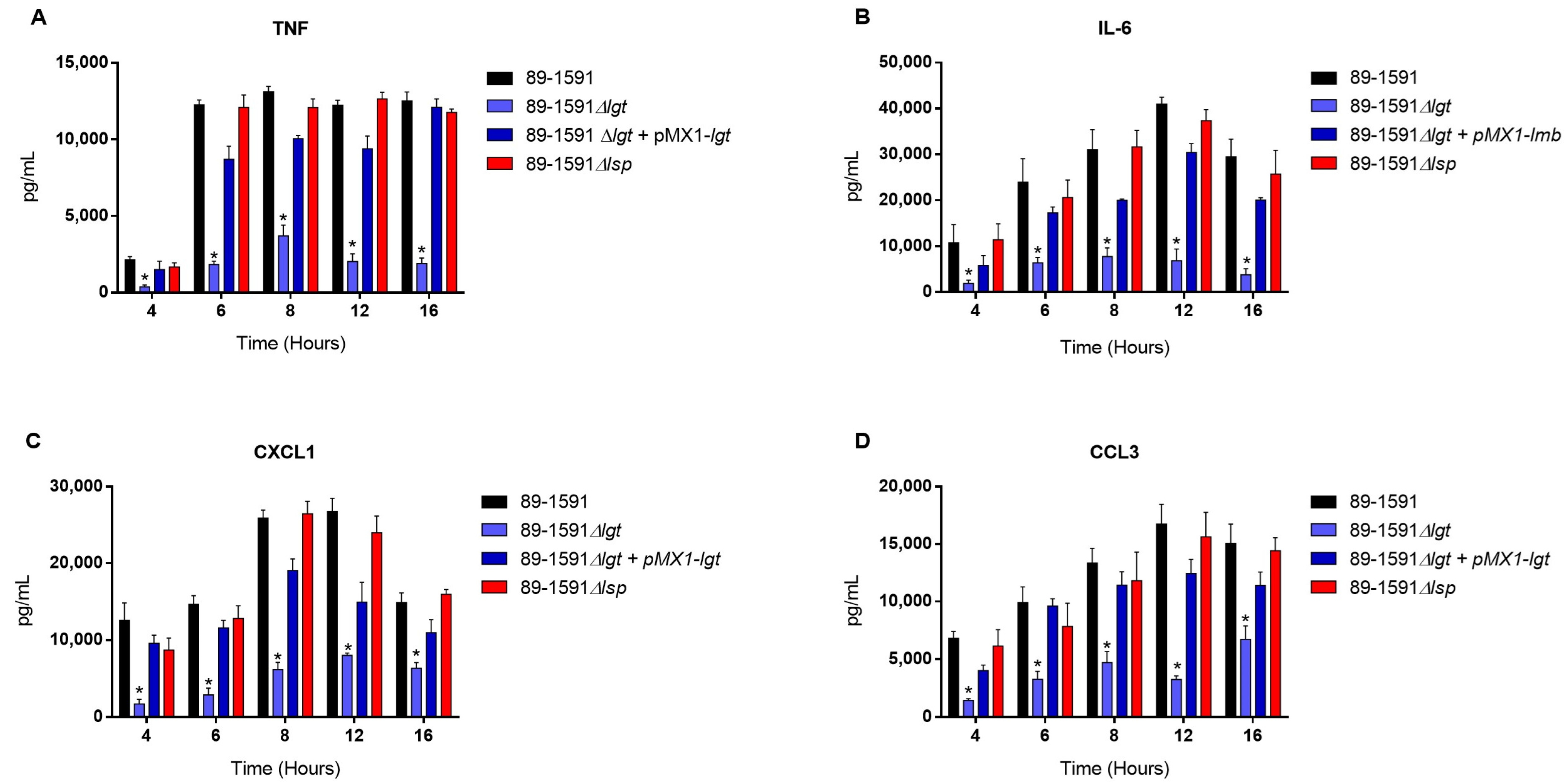

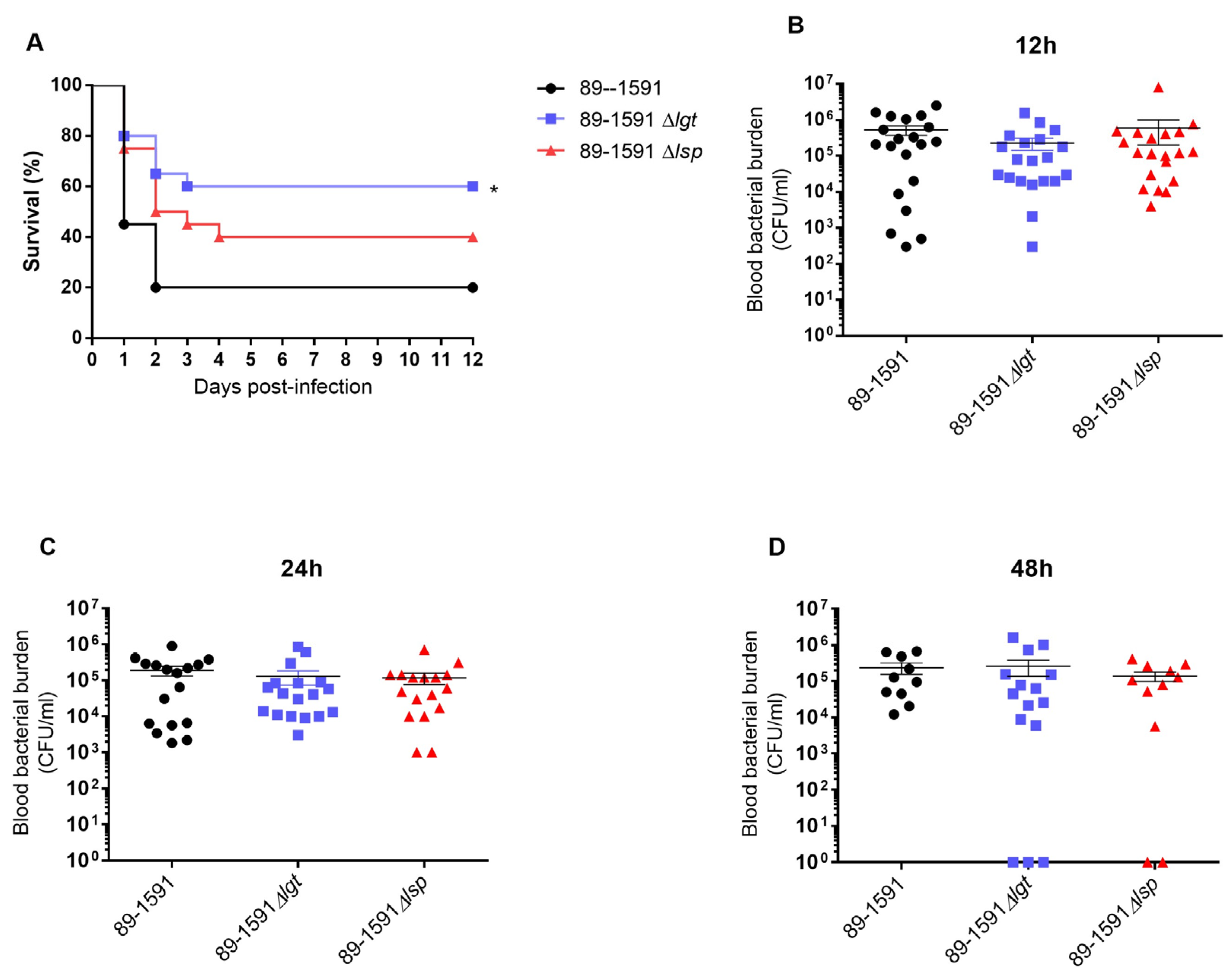

| Strain or Plasmid | Characteristics | References |
|---|---|---|
| Streptococcus suis | ||
| P1/7 | Virulent serotype 2 ST1 strain isolated from a case of pig meningitis in the United Kingdom | [21] |
| P1/7 Δlgt | Isogenic mutant derived from P1/7; in frame deletion of lgt gene | [8] |
| P1/7 Δlsp | Isogenic mutant derived from P1/7; in frame deletion of lsp gene | [8] |
| P1/7 comp Δlgt | Mutant Δlgt complemented with pMX1-lgt complementation vector | [8] |
| P1/7 comp Δlsp | Mutant Δlsp complemented with pMX1-lsp complementation vector | [8] |
| P1/7 ΔcpsF | Isogenic mutant derived from P1/7; in frame deletion of cpsF | [22] |
| 89-1591 | Virulent North American ST25 strain isolated from a case of pig sepsis in Canada | [23] |
| 89-1591 Δlgt | Isogenic mutant derived from 89-1591; in frame deletion of lgt gene | This study |
| 89-1591 Δlsp | Isogenic mutant derived from 89-1591; in frame deletion of lsp gene | This study |
| 89-1591 comp Δlgt | Mutant Δlgt complemented with pMX1-lgt complementation vector | This study |
| 89-1591 comp Δlsp | Mutant Δlsp complemented with pMX1-lsp complementation vector | This study |
| 89-1591 ΔcpsF | Isogenic mutant derived from 89-1591; in frame deletion of cpsF | [16] |
| Escherichia coli | ||
| TOP10 | F− mrcA Δ(mrr-hsdRMS-mcrBC) φ80 lacZΔM15 ΔlacX74 recA1 araD139 Δ(araleu) 7697 galU galK rpsL (Strr) endA1 nupG | Invitrogen |
| MC1061 | F− Δ(ara-leu)7697 [araD139]B/r Δ(codB-lacI)3 galK16 galE15 λ-e14-mcrA0 relA1 rpsL150(StrR) spoT1 mcrB1 hsdR2(r-m+)Host for pMX1 derivatives | [24] |
| Plasmids | ||
| pCR2.1 | Apr, Kmr, pUC ori, lacZΔM15 | Invitrogen |
| pSET4s | Spcr, pUC ori, thermosensitive pG+host3 ori, lacZΔM15 | [25] |
| pMX1 | Replication functions of pSSU1, MCS pUC19 lacZ Spcr, malX promoter of S. suis, derivative of pSET2 | [25,26] |
| p4Δlgt | pSET-4s carrying the construct for lgt allelic replacement | This study |
| p4Δlsp | pSET-4s carrying the construct for lsp allelic replacement | This study |
| pMX1-lgt (P1/7) | pMX1 carrying intact lgt gene | [8] |
| pMX1-lsp (P1/7) | pMX1 carrying intact lsp gene | [8] |
| pMX1-lgt (89-1591) | pMX1 carrying intact lgt gene | This study |
| pMX1-lsp (89-1591) | pMX1 carrying intact lsp gene | This study |
| Name | Sequence (5′–3′) | Construct |
|---|---|---|
| lgt-ID1 | GGAACGCTATGGAACAGGTC | p4Δlgt |
| lgt-ID2 | CACTCCATGAAAAGGCGACG | p4Δlgt |
| lgt-ID3 | CGTAGACGGCCAAAATTCC | p4Δlgt |
| lgt-ID4 | CGCTTATCTGCTGGATTCTCC | p4Δlgt |
| lgt-ID5 | GCCAATCGTCTGCATCAAGG | p4Δlgt |
| lgt-ID6 | GGGTTGATAGAATGGGATTGCATACCAACG | p4Δlgt |
| lgt-ID7 | CGTTGGTATGCAATCCCATTCTATCAACCC | p4Δlgt |
| lgt-ID8 | GACCGACTTGCTGGTCAAAC | p4Δlgt |
| lsp-ID1 | TGAGAAAACTGTTGTGGGTA | p4Δlsp |
| lsp-ID2 | AGAGCACCAGCAATCATCAA | p4Δlsp |
| lsp-ID3 | TTGATGATTGCTGGTGCTCT | p4Δlsp |
| lsp-ID4 | TAGACAGCGAACAGAGATAC | p4Δlsp |
| lsp-ID5 | TACGCTACGTTGTAGCCATTGC | p4Δlsp |
| lsp-ID6 | ACCTACACCAACTGTTAATACTACCATCAA | p4Δlsp |
| lsp-ID7 | TTGATGGTAGTATTAACAGTTGGTGTAGGT | p4Δlsp |
| lsp-ID8 | CGCGCTGCAGCCAAAGTGTAGTCACCAAAA | p4Δlsp |
| pMX1-lgt-F | CCGCCATGGACAGATGGGGTTTGATGCAAC | pMX1-lgt |
| pMX1-lgt-R | CGCGAATTCGGACAAGGCAATAATCAAGAC | pMX1-lgt |
| pMX1-lsp-F | GTGCCATGGACTTTATTGAAACCATGCAGG | pMX1-lsp |
| pMX1-lsp-R | ATCGAATTCAATACCACCAACCTCAACTCT | pMX1-lsp |
Disclaimer/Publisher’s Note: The statements, opinions and data contained in all publications are solely those of the individual author(s) and contributor(s) and not of MDPI and/or the editor(s). MDPI and/or the editor(s) disclaim responsibility for any injury to people or property resulting from any ideas, methods, instructions or products referred to in the content. |
© 2023 by the authors. Licensee MDPI, Basel, Switzerland. This article is an open access article distributed under the terms and conditions of the Creative Commons Attribution (CC BY) license (https://creativecommons.org/licenses/by/4.0/).
Share and Cite
Payen, S.; Roy, D.; Okura, M.; Segura, M.; Gottschalk, M. Study of the Role of Lipoprotein Maturation Enzymes in the Pathogenesis of the Infection Caused by the Streptococcus suis Serotype 2 Sequence Type 25 North American Prototype Strain. Pathogens 2023, 12, 1325. https://doi.org/10.3390/pathogens12111325
Payen S, Roy D, Okura M, Segura M, Gottschalk M. Study of the Role of Lipoprotein Maturation Enzymes in the Pathogenesis of the Infection Caused by the Streptococcus suis Serotype 2 Sequence Type 25 North American Prototype Strain. Pathogens. 2023; 12(11):1325. https://doi.org/10.3390/pathogens12111325
Chicago/Turabian StylePayen, Servane, David Roy, Masatoshi Okura, Mariela Segura, and Marcelo Gottschalk. 2023. "Study of the Role of Lipoprotein Maturation Enzymes in the Pathogenesis of the Infection Caused by the Streptococcus suis Serotype 2 Sequence Type 25 North American Prototype Strain" Pathogens 12, no. 11: 1325. https://doi.org/10.3390/pathogens12111325






